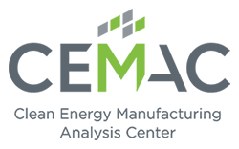Clean Energy Manufacturing Analysis Center Methodology and Capabilities
The Clean Energy Manufacturing Analysis Center's (CEMAC's) analysis capabilities inform the international clean energy manufacturing dialogue. CEMAC applies its consistent methodology to investigate the potential impacts on the U.S. and global economy from expanding renewable technology deployment and examine opportunities for manufacturers within the clean energy market space.
Analysis Methodology
CEMAC's consistent approach to clean energy manufacturing and supply chain analysis forms the basis of all analysis delivered, can inform others who wish to carry out similar analysis, and can catalyze the development of standards, shared data, and tools for a community of practice in this area.
CEMAC has established a methodology to evaluate quantitative and qualitative elements that contribute to clean energy manufacturing. The work can be broken into the following steps:
- Global supply chain assessment and benchmarking
- Comparative cost analysis
- Analysis of the impact of qualitative factors
- Sensitivity analysis.
Each step of the analysis is geared toward the identification of insights that can be used by decision-makers to support investments in research or policies targeted to advancing the commercialization and manufacturing of clean energy technologies. As such, sensitivity analysis is critical to the evaluation of the relative importance of key inputs.
Analysis Capabilities
CEMAC's analysis expertise includes:
- Clean energy innovation analysis
Understanding the innovation dynamics of clean energy technologies can help inform research investment decisions and innovation and technology transfer policy. - Competitive advantage market analysis
Identifying the key global market drivers and opportunities within various markets. - Jobs analysis
Studying investments in clean energy technology deployment can result in positive returns on investment and shed light on related job creation and economic output at the national, state, and community levels. - Cost analysis
Examining the regional manufacturing points and access to capital as a critical component for innovation. - Supply constraints analysis
Understanding rare material constraints and how they could limit the scale of rare material-based photovoltaic PV technology deployment and may influence manufacturing strategy. - Workforce development analysis
Examining specific workforce skills, training, and experience and establishing associated standards and requirements will continue to encourage large-scale deployment of wind and solar technologies.

